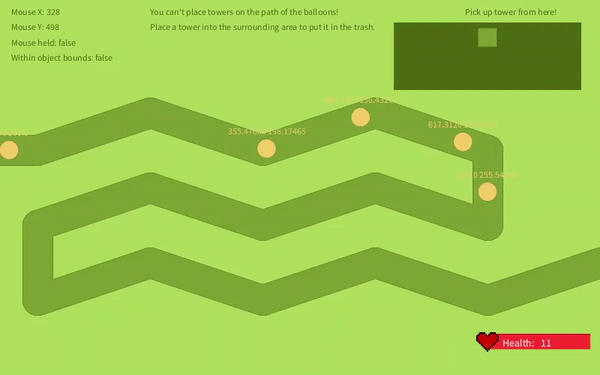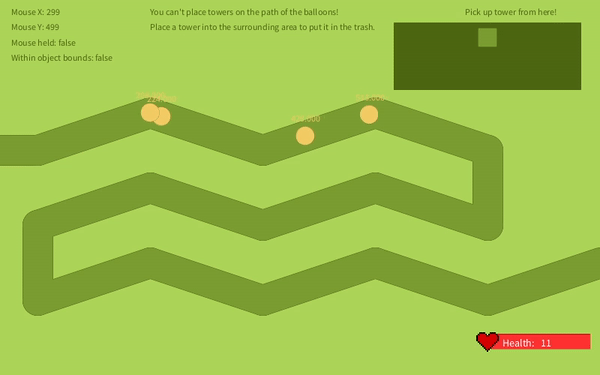Our solution can be split into two simpler steps:
- Looping through the “lines” formed by each consecutive pair of points, and finding which of the lines our balloon is currently on.
- Finding the coordinate of the balloon given its progress along the smaller line.
Line Identification
To find out which one of the lines our balloon is currently on, we can iterate through each of the points that make up our path, “travelling” from one point to the next.
We can store a variable representing total remaining distance to find which of the lines our balloon currently lies on. Let us call this variable remainingDist.
At the beginning, this distance will be equal to the total travel distance that is inputted via the method parameter.
When we start looping through the ArrayList, we will compare the length of the current line and the remaining distance left to travel.
Line Indexes
Recall that at a line is made up of two consecutive PVectors.
To iterate through each line, we use a for loop, such that at every index i, the line is composed of points.get(i) and points.get(i + 1). To prevent errors, we will loop to the second-last index rather than the last, as points.get(i + 1) will otherwise attempt to access an index out of bounds.
The length of the current line can be found using the built-in dist(float x1, float y1, float x2, float y2) function to find the distance between two points using the pythagorean theorem.
Let’s say we have an imaginary balloon that is moving along the path and needs to travel the initial travelDistance.
If the remaining distance left to travel is greater than or equal to the length of the line we’re on, we can move to the next point in the path. The remaining distance left to travel now decreases by the length of this line.
If the remaining distance left to travel is smaller than the length of the line we’re on, this must mean that the balloon is directly on top of this current line formed by points.get(i) and points.get(i + 1). We can now move on to the second step and exit out of our loop.
- If by the end of the loop, the remaining distance left to travel is still greater than zero (and thus, we have not broken out of the loop), this means that we have travelled to the end of the path, and can return the last point inside the path.
Progress Identification
Now that we know which two points our line is between, we can use math to figure out the exact location of our balloon.
If our remainingDist is not zero at this point, we will still have some distance left to travel along the line we are currently on, starting from the point, points.get(i).
Let us call this point, currentPoint and the next point that forms a line with the current point, nextPoint.
In order to figure out where our balloon is, we can find a percent ratio between remainingDist and the length of the current line. This effectively gives us the progress travelled along the current line.
By breaking down this line into horizontal and vertical components, we can determine the distance you will need to travel left/right and the distance you will need to travel up/down to get from currentPoint to nextPoint.
Multiplying these components by the aforementioned progress will give us the exact values for how far left/right and how far up/down our balloon has travelled from currentPoint. Adding these new values to the co-ordinates of currentPoint will thus yield us with the location of the balloon, ready to return from our function!
Full Code
PVector getLocation(float travelDistance)
{
float remainingDist = travelDistance;
for (int i = 0; i < points.size() - 1; i++) {
PVector currentPoint = points.get(i);
PVector nextPoint = points.get(i + 1);
float distance = dist(currentPoint.x, currentPoint.y, nextPoint.x, nextPoint.y);
// Finding the length of an individual line using the built-in dist() function (Pythagorean Theorem)
if (remainingDist < distance) {
// Step 2 - In between two points
float travelProgress = remainingDist / distance;
// travelProgress is the percent ratio of the remaining travel distance and the distance of the line the balloon is on
// This will always be less than 1, if it was greater, this else code wouldn't run (remainingDist >= distance)
float xDist = nextPoint.x - currentPoint.x;
float yDist = nextPoint.y - currentPoint.y;
// We take the x and y distance between the two points along the line, multiply these distances by the ratio and add them to the FIRST point to get the specific location
// This works because our ratio represents the travel progress - if it is close to 0, we are close to the first point, if it is close to 1, it is close to the second point
float x = currentPoint.x + xDist * travelProgress;
float y = currentPoint.y + yDist * travelProgress;
return new PVector(x, y);
} else {
remainingDist -= distance;
// As we loop through lines, we subtract the length of the line from the travel distance. This signifies a "remainding" travel distance from the nextPoint.
// If the remaining travel distance is SMALLER than the distance of our current line, we know that we are in between two points and we can move onto the second step.
}
}
// At end of path
return points.get(points.size() - 1);
}

